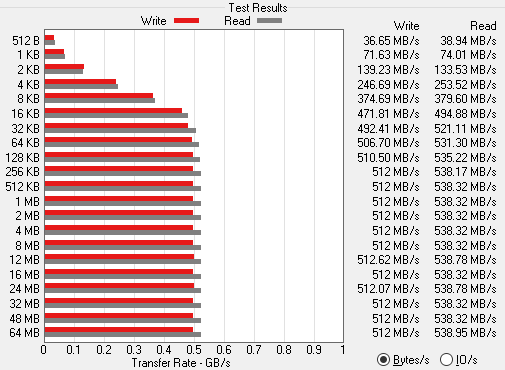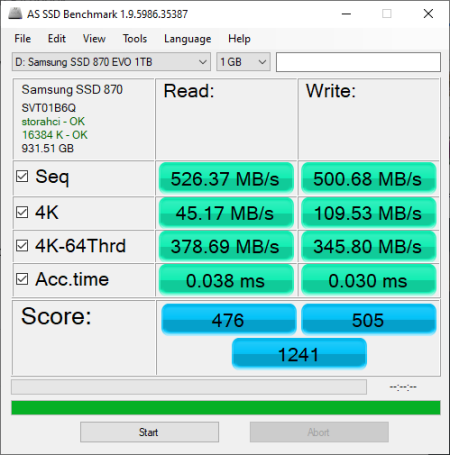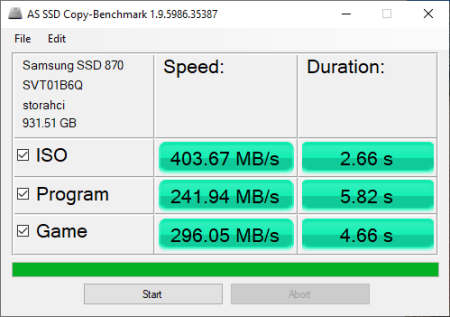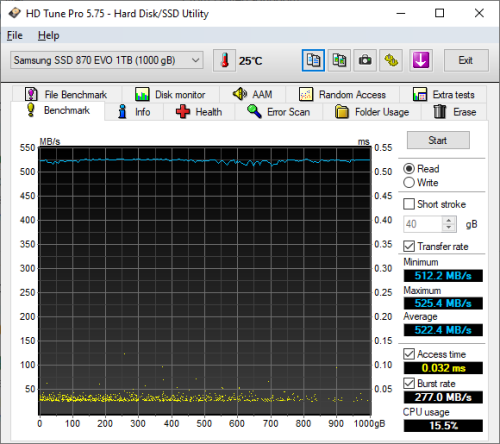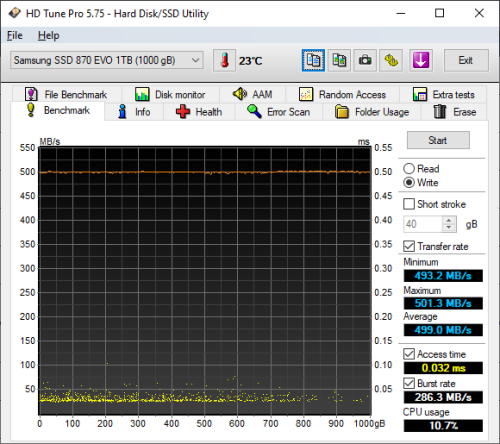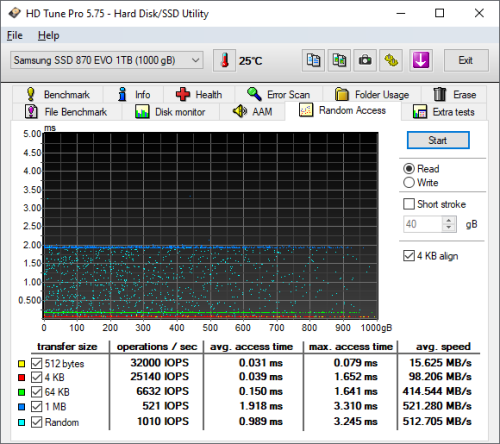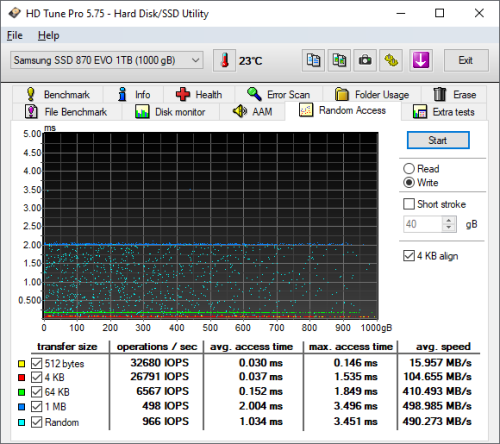

Model: Crucial MX500 4TB Solid State Drive
Manufacturer: Crucial
Provided By: Crucial
Crucial is a global brand of Micron Technology, Inc., one of the largest memory and flash storage manufacturers in the world. The company's product lineup includes award-winning solid state drives (SSDs) and computer memory upgrades (DRAM) for more than 50,000 systems. These products have been qualified and approved by major original equipment manufacturers and every single module has been rigorously tested at the component and module level. Each SSD also undergoes over a thousand hours of prerelease validation testing and hundreds of qualification tests to ensure optimal reliability and performance.
This fall, Crucial released a 4TB version of its award winning MX500 SSD. Powered by Silicon Motion's SM2259 controller and equipped with 4TB of Micron's industry-leading 176-layer 3D TLC NAND flash, the drive delivers 560 MB/s read and 510 MB/s write speeds. Like the other drives in the series, the 4TB MX500 also offers a long list of features including AES 256-bit encryption, thermal and power loss protection, TRIM support and active garbage collection. It also comes equipped with Crucial's Dynamic Write Acceleration technology, which uses an adaptable pool of high speed, single-level cell flash memory to enable faster saves and file transfers. Last, but not least, the MX500 uses technologies like Data Defense and Redundant Array of Independent NAND (RAIN) to maintain the integrity of your data and prevent it from becoming corrupted.
The MX500 is available in 250GB, 500GB, 1TB, 2TB and 4TB capacities. For this review, Crucial sent us the new 4TB version of the drive which is capable of delivering up to 560 MB/s sequential read and 510 MB/s sequential write speeds as well as up to 95,000 random read and 90,000 random write IOPS.
| Crucial MX500 4TB Solid State Drive | |||||||||||||||||||||||||||
General Specifications
Performance
Reliability
Environmental
Other Features
|
Needless to say, this is only a taste of what the MX500 has to offer. To give you an idea of what to expect, we'll take a closer look at Crucial's new 4TB SSD and then see how well it performs. Does the MX500 have what it takes? Can it deliver the performance and features that we've come to expect from Crucial? Keep reading as we find out.
The MX500 comes in a small, blue box. While there aren't a lot of technical details, the packaging provides basic information like the drive's capacity and a list of the box's contents. Inside, you'll find the SSD, a mounting spacer for use with traditional 9.5mm drive bays and a small guide with information on where you can get additional help and download the migration and cloning software.
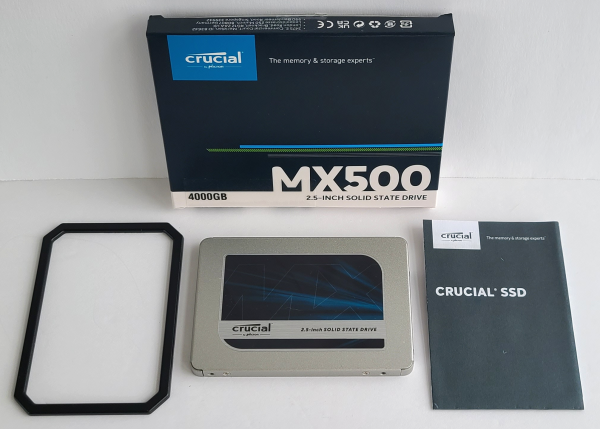
Physical Features:
The MX500 looks very similar to Crucial's other 2.5-inch SSDs. The outer casing is made entirely out of metal and is covered by a grey, textured finish. The top of the drive also has a large, blue and gray sticker showing that it is part of Crucial's MX series.

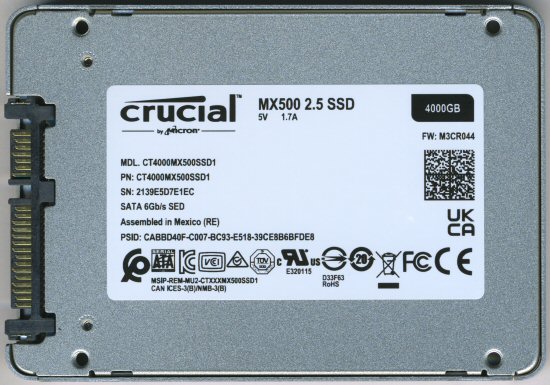
While earlier versions of the MX500 used Silicon Motion's SM2258 controller, the 4TB model is equipped with the SM2259. Designed for use in cost-effective, small form factor and low power SSDs, this SATA 6Gb/s controller has four channels with up to eight chip enables (CE) per channel. The SM2259 also supports 3D NAND flash from all major suppliers and features Silicon Motion's proprietary NANDXtend error-correcting code (ECC) technology as well as Direct-to-TLC and SLC caching algorithms for optimal sustained performance.
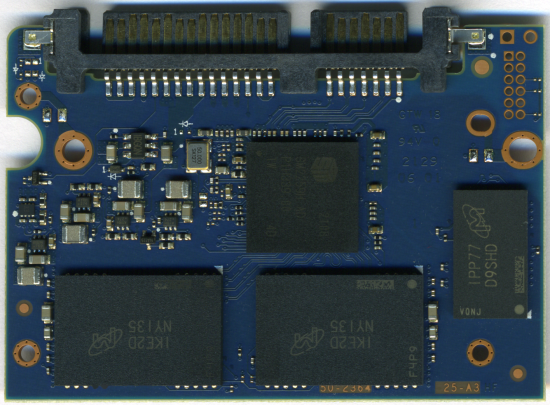
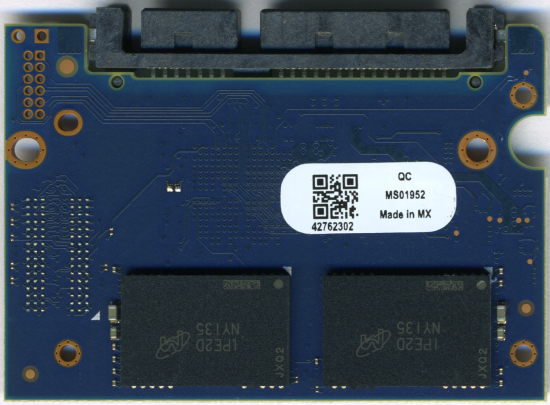
For the 4TB version of the MX500, Crucial opted to use Micron's 176-layer (B47R) 3D TLC NAND flash. Looking at the picture above, you can see that there are two 1TB NAND flash packages on either side of the PCB. The drive also has a single 512MB Micron DDR3L memory chip that is used for caching.
The test system used in this review is equipped with an AMD Ryzen 3 3100 CPU, MSI B550 GAMING PLUS motherboard, 16GB (8GB x 2) of Crucial Ballistix 3200 MHz DDR4 memory, Crucial P5 1TB SSD and a GIGABYTE GeForce GTX 1060 WINDFORCE OC 6G graphics card. For the operating system, I used the latest version of Windows 10 Pro.
To test the performance of Crucial's MX500 SSD, I ran a series of benchmarks using CrystalDiskMark, HD Tach RW, ATTO Disk Benchmark, AS SSD, HD Tune Pro, Anvil's Storage Utilities, Iometer and PCMark 8. For comparison, I've also included test results from the Lexar NQ100, Samsung 870 EVO, Samsung 870 QVO, SK hynix Gold S31, ADATA Ultimate SU750, Samsung 860 QVO, Samsung 860 PRO, Crucial MX500, Plextor M8V, Crucial BX300, ADATA Ultimate SU900, Plextor S3C, Toshiba OCZ VX500, ADATA Ultimate SU800, Plextor S2C, Crucial MX300, Plextor M7V, PNY CS1311, OCZ Trion 150, PNY CS2211, Plextor M6V, Crucial BX200, OCZ Trion 100, Kingston HyperX Savage, Crucial MX200, OCZ Vector 180, Kingston BX100, Samsung 850 EVO M.2, Samsung 850 EVO mSATA, AMD Radeon R7, Silicon Power Slim S80, Samsung SSD 850 EVO, OCZ ARC 100, SanDisk Ultra II, Crucial MX100, SanDisk Extreme Pro and Samsung SSD 850 PRO.

As I mentioned earlier, the Crucial MX500 is based on SMI's SM2258 controller chip. Looking at the screenshot above, you can see that it performs equally well with both incompressible (0%) and compressible (100%) data.
CrystalDiskMark 8.0.4:
First, I ran a few quick tests using CrystalDiskMark. This benchmark measures the performance of a storage device by testing its sequential and random read and write speeds. For this test, we're using the peak and real world profiles.

According to Crucial, the 4TB version of the MX500 is capable of reading at 560 MB/s and writing at 510 MB/s. As you can see, the drive had no problems reaching these speeds in CrystalDiskMark's sequential read and write tests.

As you'd expect, the MX500 wasn't nearly as fast when tested with the "real world" profile which uses a single thread and a much lower queue depth. Nevertheless, it was still able to read at 460 MB/s and write at more than 503 MB/s.
HD Tach RW 3.0.4.0:
Next, I used HD Tach to test the MX500's read, write and burst speeds as well as its seek times and CPU usage.

Looking at the screenshot above, you can see that the MX500 had average read and write speeds of 333.8 MB/s and 350.5 MB/s respectively, as well as a burst speed of 349.6 MB/s. The screenshot also shows that, like most other TLC-based SSDs, the MX500 uses some sort of SLC caching. The drive starts writing at about 400 MB/s and then drops to about 250 MB/s when the write operation exceeds the size of the cache. Oddly enough, it jumped back up to 350 MB/s after a period of time.
ATTO Disk Benchmark 4.01:
I also used ATTO Disk Benchmark to test the MX500's sequential read and write speeds. The tests are run using blocks ranging in size from 512B to 64 MB and the total length set to 256MB.
When tested with ATTO, the MX500's read speeds topped out at about 538 MB/s and its write speeds at 493 MB/s.
AS SSD:
AS SSD is a benchmark designed specifically for solid state drives. The application contains five synthetic tests which are used to determine the sequential and random read and write performance of a drive.
AS SSD also includes a copy benchmark. This test copies an ISO (two large files), program (many small files) and game (small and large files), returning the speed and duration of each.
HD Tune Pro 5.75:
Next, I ran a series of tests using HD Tune Pro. This hard disk utility measures a drive's performance by testing its sequential read and write speeds as well as its access time, burst rate and CPU usage. For this review, I'm also going to use it to benchmark the MX500's random read and write speeds, random access times and the number of operations per second.
The MX500 performed relatively well when benchmarked with HD Tune. The drive had average read and write speeds of 496.9 MB/s and 457.9 MB/s, respectively.
When reading 4KB blocks, the MX500 reached 24,976 IOPS and had an average speed of 97.566 MB/s. The drive was slightly faster when writing, reaching 26,093 IOPS with an average speed of 101.927 MB/s.
Anvil's Storage Utilities:
Anvil's Storage Utilities is another benchmark designed with SSDs in mind. The standard storage benchmark measures a drive's performance by testing its transfer speeds, access times and IOPS.

Iometer:
Lastly, I ran a series of tests using Iometer. This tool can be configured to benchmark a number of things. In this case, I used it to measure the MX500's read and write speeds and the number of operations per second. The tests were run using random bytes and a queue depth of 3.

The MX500's performance was very similar to what we saw in our other tests. The drive was able to read at 537.74 MB/s and write at 491.05 MB/s.

The MX500 also performed fairly well when doing random reads and writes. In our tests, the drive was able to read at 180.17 MB/s and write at a respectable 306.55 MB/s.
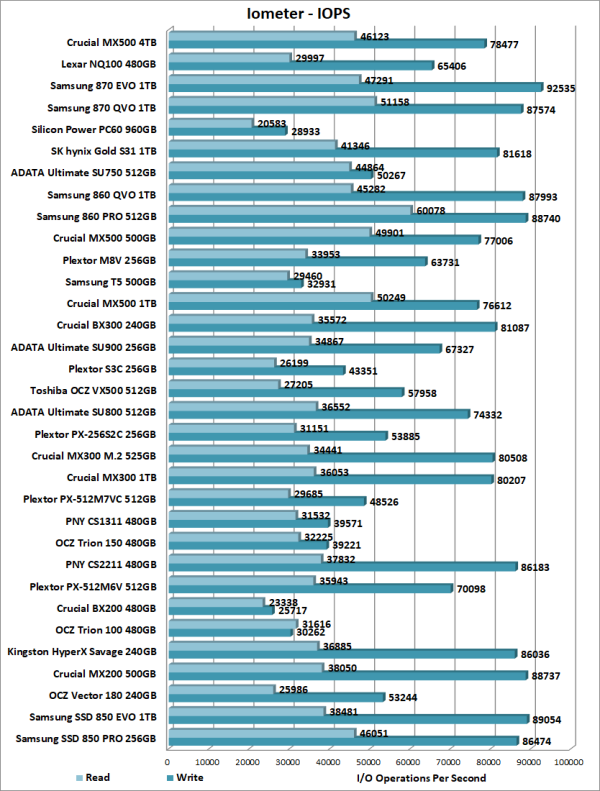
According to Crucial, the 4TB MX500 is capable of 90,000 IOPS when reading and writing 4K blocks. In our tests, the drive reached 46,123 random read IOPS and 78,477 random write IOPS. As with most drives, the MX500 performed better at higher queue depths. With four threads and the queue depth set to 32, the drive was able to reach 83,908 random read IOPS and 92,097 random write IOPS.
Vantage PCMark 8 - Storage Test:
PCMark 8 is a complete benchmark for Windows. It includes five benchmark tests, each designed around a specific scenario. The storage benchmark measures drive performance using real-world traces recorded from Adobe Creative Suite, Microsoft Office and a selection of popular games.

PCMark 8 also includes a consistency test which measures the performance consistency and degradation tendency of a storage system. The test reports the performance level at the start, the degraded steady-state and the recovered state as well as the number of iterations required to reach them. For this test, we are focusing on the Adobe Photoshop (Heavy) trace and will look at both the bandwidth and latency of the drive


The MX500's performance was hit and miss in this test. While the drive started out strong, its bandwidth eventually dropped below 100 MB/s, pushing its latency well above the 400ms mark. The MX500 never really recovered either. During the recovery phase, its bandwidth topped out at a mere 66 MB/s.
PCMark 10 - Full System Drive Benchmark:
PCMark 10's Full System Drive Benchmark uses a wide-ranging set of real-world traces from popular applications and common tasks to fully test the performance of the fastest modern drives. This benchmark produces an overall score as a measure of drive performance. Comparing devices is as simple as comparing scores. The tests also measure and report the bandwidth and average access time performance for the drive.

TRIM Performance:
While SSD's offer many benefits, there are some downsides to using flash memory. One of the biggest issues people run into is performance degradation. Over time, an SSD will run out of fresh blocks and will have to write over data the file system has marked as deleted. This procedure is very complicated and can slow an SSD's write speeds considerably.
To fix this problem, most manufacturers have added TRIM support to their SSDs. The TRIM command allows an operating system, such as Windows 10, to tell an SSD which data blocks are no longer in use. Using this information, the drive pro-actively erases these blocks and adds them to the free block pool.
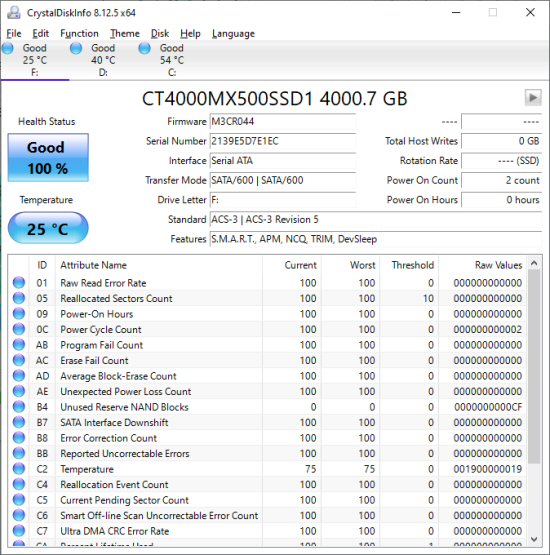
To test the MX500's TRIM and garbage collection functions, I first put the drive in a "dirty" state. I used Iometer to fill 80% of the drive and then ran a random write test for about 45 minutes. This had little impact on the MX500's read speed. However, its average writing speed dropped to 235.75 MB/s.

Crucial MX500 - Dirty
To see how well the MX500 could recover, I let the computer sit for about 30 minutes and then reran the test. The drive wasn't able to reach the factory fresh performance shown in our earlier tests. However, its sequential write speed jumped up to 465.71 MB/s.

Crucial MX500 - After TRIM
Lastly, I used Parted Magic to perform a secure erase on the MX500. With the drive wiped clean, it had average read and write speeds of 524.82 MB/s and 491.59 MB/s, respectively.

Crucial MX500 - Secure Erased
Final Thoughts:
Crucial's MX500 SSD has been around for a number of years now and, while some may see it as being a bit long in the tooth, it remains one of the best SATA drives on the market today. The new 4TB version of the MX500 is no exception. Powered by Silicon Motion's SM2259 controller, this high-capacity drive uses Micron's latest 176-layer 3D TLC NAND flash to deliver good performance, enhanced features and a high level of endurance at a competitive price. In our sequential read and write tests, the 4TB version of the MX500 was able to read at speeds as high as 564 MB/s and write at speeds in excess of 515 MB/s. It also did fairly well in our random write tests, producing more than 78,000 IOPS at low queue depths.
Of course, performance and capacity aren't the only things the MX500 has to offer. Along with thermal and power loss protection, TRIM support and active garbage collection, the drive features AES 256-bit full disk encryption and is compatible with both the TCG Opal and IEEE 1667 specifications. The MX500 also uses Dynamic Write Acceleration to enable faster saves and file transfers, and technologies like Data Defense and Redundant Array of Independent NAND (RAIN) to protect data at the component level and prevent it from becoming corrupted. Last, but not least, the MX500 supports the SATA Device Sleep (DEVSLP) standard which extends the battery life of a device by reducing the drive's power consumption when it's not in use.
The Crucial MX500 is available now in 250GB, 500GB, 1TB, 2TB and 4TB capacities. Prices on Amazon.com currently range from $50 up to $360 for the 4TB version reviewed here.

Highs:
- Silicon Motion 2259 controller
- Micron 176-layer 3D TLC NAND
- Good sequential and random read and write performance
- Dynamic Write Acceleration, Data Defense and RAIN technologies
- AES 256-bit full disk encryption
- TCG Opal and IEEE 1667 compliant
- DEVSLP power mode
- Supports TRIM, SMART and active garbage collection
- Thermal and power loss protection
- Ultra-slim form factor
- Works with Crucial's Storage Executive software
- Includes 9.5mm spacer and data migration software
- 5 year warranty
- Reasonably priced
Lows:
- Write speed drops when SLC cache is full



